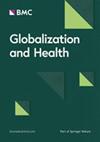Classifying disaster risk reduction strategies: conceptualizing and testing a novel integrated approach
IF 4.5
2区 医学
Q1 PUBLIC, ENVIRONMENTAL & OCCUPATIONAL HEALTH
引用次数: 0
Abstract
Although disaster risk reduction (DRR) addresses underlying causes and has been shown to be more cost-effective than other emergency management efforts, there is lack of systematized DRR categorization, leading to insufficient coherence in the terminology, planning, and implementation of DRR. The aim of this study was to conceptualize and test a novel integrated DRR framework that highlights the intersection between two existing classification systems. Grounded theory was used to conceptualize a novel DRR framework. Next, deductive conceptual content analysis was used to categorize interventions from the 2019 Cities100 Report into the proposed DRR framework. The term “connection” indicates that an intervention can be categorized into a particular section of the novel integrated approach. A “connection” was determined to be present when the intervention description stated an explicit connection to health and to the concept within one of the categories from the novel approach. Further descriptive statistics were used to give insight into the distribution of DRR interventions across categories and into the application of the proposed framework. The resulting framework contains nine intersecting categories: “hazard, prospective”, “hazard, corrective”, “hazard, compensatory”, “exposure, prospective”, “exposure, corrective”, “exposure, compensatory”, “vulnerability, prospective”, “vulnerability, corrective”, and “vulnerability, compensatory”. The thematic analysis elucidated trends and gaps in the types of interventions used within the 2019 Cities100 Report. For instance, exposure-prospective, exposure-compensatory, and vulnerability-compensatory were the most under-utilized strategies, accounting for only 3% of the total interventions. Further descriptive statistics showed that upper middle-income countries favored “hazard, corrective” strategies over other DRR categories while lower middle-income countries favored “exposure, corrective” over other DRR strategies. Finally, European cities had the highest percentage of DRR connections (51.39%) compared to the maximum possible DRR connections, while African cities had the lowest percentage of DRR connections (22.22%). The study suggests that the proposed DRR framework could potentially be used to systematically evaluate DRR interventions for missing elements, aiding in the design of more equitable and comprehensive DRR strategies.减少灾害风险战略的分类:构思和测试一种新的综合方法
尽管减少灾害风险(DRR)可以解决根本原因,而且与其他应急管理工作相比,其成本效益更高,但目前缺乏系统化的减少灾害风险分类,导致减少灾害风险的术语、规划和实施缺乏一致性。本研究的目的是构思并测试一个新颖的综合减灾框架,该框架突出了两个现有分类系统之间的交叉点。本研究采用基础理论对新型减灾框架进行概念化。接下来,使用演绎概念内容分析法将《2019 年城市 100 报告》中的干预措施归入拟议的减灾框架。术语 "联系 "表示干预措施可归入新型综合方法的特定部分。当干预措施的描述中明确指出与健康和新方法中某一类别中的概念有关时,就可以确定存在 "联系"。进一步的描述性统计用于深入了解减少灾害风险干预措施在各个类别中的分布情况以及拟议框架的应用情况。由此得出的框架包含九个相互交叉的类别:"危险,前瞻性"、"危险,纠正性"、"危险,补偿性"、"暴露,前瞻性"、 "暴露,纠正性"、"暴露,补偿性"、"脆弱性,前瞻性"、"脆弱性,纠正 性 "和 "脆弱性,补偿性"。专题分析阐明了《2019 年城市 100 报告》中使用的干预类型的趋势和差距。例如,"暴露前瞻性"、"暴露补偿性 "和 "脆弱性补偿性 "是使用率最低的策略,仅占干预措施总数的 3%。进一步的描述性统计显示,中上收入国家偏爱 "危害、纠正 "战略而非其他减灾战略,而中下收入国家偏爱 "暴露、纠正 "战略而非其他减灾战略。最后,与最大可能的减灾连接相比,欧洲城市的减灾连接比例最高(51.39%),而非洲城市的减灾连接比例最低(22.22%)。研究表明,建议的减灾框架可用于系统评估减灾干预措施中缺失的要素,从而帮助设计更加公平和全面的减灾战略。
本文章由计算机程序翻译,如有差异,请以英文原文为准。
求助全文
约1分钟内获得全文
求助全文
来源期刊

Globalization and Health
PUBLIC, ENVIRONMENTAL & OCCUPATIONAL HEALTH-
CiteScore
18.40
自引率
1.90%
发文量
93
期刊介绍:
"Globalization and Health" is a pioneering transdisciplinary journal dedicated to situating public health and well-being within the dynamic forces of global development. The journal is committed to publishing high-quality, original research that explores the impact of globalization processes on global public health. This includes examining how globalization influences health systems and the social, economic, commercial, and political determinants of health.
The journal welcomes contributions from various disciplines, including policy, health systems, political economy, international relations, and community perspectives. While single-country studies are accepted, they must emphasize global/globalization mechanisms and their relevance to global-level policy discourse and decision-making.
 求助内容:
求助内容: 应助结果提醒方式:
应助结果提醒方式:


